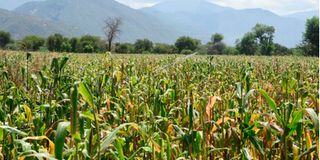Kenya faces food crisis as drought depresses production

A farmer in Elburgon, Nakuru County, sprays his maize crop with pesticide in June 2021.
Pushed by rising production costs and ensuing low returns, most cereal farmers in the North Rift region, the country’s food basket, are diversifying to coffee, horticulture and commercial farm forestry.
Returns from maize and wheat, they say, have declined due to rising costs of farm inputs and unstable market prices rendering investment in the sub-sector unprofitable.
The cost of fertiliser has increased from Sh3,200 to Sh6,400, maize seed from Sh4,700 to Sh5,000.

A farmer desperately attempts to chase eating her maize plants in Meru county on February 8, 2021. If not addressed fast, pests and diseases can destroy farmers’ crops and livelihoods.
Among farmers who have shifted from cereal farming to more profitable ventures is Peter Boit, a large-scale farmer who for many years grew maize for seed multiplication.
He has diversified to coffee production and private farm forestry, which he says bring better returns compared with maize and wheat.
“Maize cultivation is no longer a profitable venture due to high investment but low returns. Cartels in the supply market chain cause artificial shortages before harvest season to flood the market with cheap imports, lowering prices for local produce” said Mr Boit, a coffee farmer in Uasin Gishu County.
Maize production in the Rift Valley dropped from 21 million to 15 million bags last season due to erratic rainfall and disease outbreaks.
Just like other commercial farmers in the region who are embracing diversification to cut down costs and earn better returns, Mr Boit has invested in coffee farming as an alternative source of income.
“Coffee payments have drastically improved over the year and this has encouraged farmers to improve their crop husbandry.”
A kilo of cherry goes for Sh60, up from Sh43; parchment for Sh310, up from Sh160; and mbuni Sh90, up from Sh45.
“Farm forestry, and in particular bamboo, is a perfect alternative,” Mr Boit added.
Private forestry is becoming a profitable trade in Western Kenya due to increased demand for wood fuel by textile and food processing industries.
The region has three categories of industrial firewood-consuming sectors that motivate farmers to venture into farm forestry, said the Kenya Forestry Research Institute (Kefri) and the Kenya Forest Service (KFS).

A maize farm at Sigor Weiwei Irrigation Scheme in West Pokot County.
They are a pulp mill (Rai Plywood), 28 tea processing factories affiliated to Kenya Tea Development Authority (KTDA) and 12 textile and food-processing industries, which all require wood fuel.
The demand for firewood by KTDA-affiliated factories is estimated at 450,000 tonnes valued at Sh675 million.
A Kefri report says that pulp, textile and food-processing industries in the region consumed about 320,000 tonnes of firewood last year valued at Sh560 million.
The industrial firewood sector has a chain demand value of over Sh1.2 billion, making the forestry sector one of the most profitable ventures that is enticing some farmers in North Rift to diversify to the sub-sector.
Firewood in the region costs Sh1,400 per cubic metre, and most farmers consider this more profitable than growing maize and wheat.





